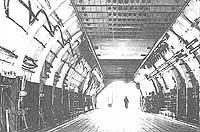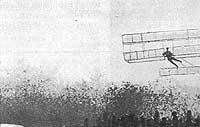Largest cargo aircraft
1988/10/01 Otaolaurretxi, Jon Iturria: Elhuyar aldizkaria

However, the cargo planes are very different from design. They usually have a large cellar, a firm pavement, special devices to tie the cargo inside, large entrance doors and easy exit of loads (minimum size of warehouse), etc. The winery also has cranes and winches for the entrance and exit of large and heavy loads, as well as ramps for loading and unloading vehicles. On the other hand, the cargo planes must land in unconditioned airports, as they transport large parts, vehicles, fragments of water, etc. To distant works. For this reason, the cargo plane must be able to land in short airports surrounded by mountains and cold climates. For all this, this type of plane has fuselage of large diameter and upper wings so that the pavement for the load is lower. In addition, taking into account its weight, it has numerous landing wheels.
In the Soviet Union, Oleg Antonov designed these aircraft, called An-8, An-, An-22, An-26 and An-32. For example, model An-22 beat all records in 1967. Then the cargo of 100.4 tons rose to 8,000 meters in height and no one advanced in another seventeen years.
However, larger and better models have been developed in the Soviet Union, with the latest An-124 Ruslan. Its main characteristics are: With a total emission capacity of 405 tons (105 tons of cargo), 6.4 meters wide, 4.4 meters high and 36 meters long (more than 1000 cubic meters), the winery has a autonomy of 16.500 kilometers and can reach a speed of 850 km/h to 11.000 meters high.
It has 24 landing wheels, but its height can be regulated. This makes when opening the doors the distance between the cellar and the floor is very small, thus facilitating the entry or exit of the loads.
These twenty-four wheels allow, on the other hand, to land or take off on tracks without concrete of 3.000 meters. When taking off, four reactors of the D18T model exert a force of 23.400 kg.
Another particularly careful aspect in this cargo plane has been that of safety. For this purpose, numerous tests have been carried out in laboratories and tracks and the work of the crew and ground controllers through computers has been greatly simplified. In addition to the computers for the government of the plane, it has quadruple electromechanical and hydraulic controls for the benefit of safety. It also presents a great "artificial" stability. The artificial stability is achieved by the automatic rotation of the fins to compensate for the adverse effects in the air by turbulence.

In June 1985, the Soviets presented the An-124 cargo plane at the Paris International Exhibition together with those of other airmen, but it was the most applauded and the one that the experts put in front line in the magazines.
The An-124 aircraft is used for transporting cargo to any corner of the broad territories of the Soviet Union, but before starting operation in July 1985 V. The pilot Terskoi beat twenty world brands in a single test flight. 171 Tm and 219 Kg. Measuring up to a height of 10.750 meters. The plane weighed a total of 380 tons.
He began working normally in 1986 and brought giant trucks to a Yakutia diamond mine.
From Vladisvostok to Udatxni transported 182 tons on a journey of 25,000 kilometers. Since then, this hercules continues to work on its air transport from one side to the other of the Soviet Union.

Gai honi buruzko eduki gehiago
Elhuyarrek garatutako teknologia




